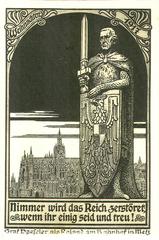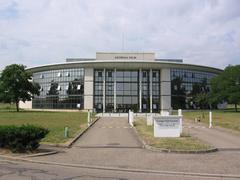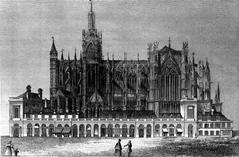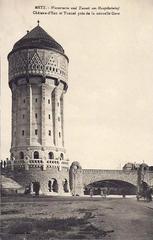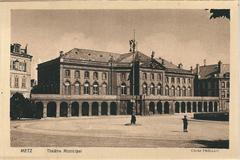Musée de la Cour d’Or Metz: Visiting Hours, Tickets, and Guide to Historical Sites in Metz
Date: 15/06/2025
Introduction
The Musée de la Cour d’Or in Metz is a cornerstone of the city’s rich cultural tapestry, offering an immersive journey through over 2,000 years of history, art, and architecture. Housed within a labyrinth of historic buildings—including Roman baths, medieval granaries, and former monastic chapels—this museum presents a unique synthesis of Metz’s Roman origins, Merovingian heritage, medieval life, and artistic evolution up to the modern era. Central to Metz’s identity, the museum’s collections and architecture vividly narrate the city’s transformation across the centuries. Whether you are a history enthusiast, art lover, or casual visitor, this guide will detail everything you need to plan your visit: opening hours, ticketing, accessibility, highlights of the collections, travel tips, and nearby attractions.
Historical Overview
Origins and Early Development
Founded in 1839, the Musée de la Cour d’Or was born of Enlightenment-era ambitions to preserve Metz’s archaeological and artistic legacy. Its name pays homage to the legendary “Golden Court,” the supposed palace of the Merovingian kings of Austrasia. The museum was initially established by the Société royale des sciences et des arts de Metz, focusing on local archaeological discoveries and the city’s Roman past. Over time, the institution expanded its collections and physical footprint, integrating significant architectural elements from across Metz (fr.wikipedia.org; wikimetz.fr).
Architectural Evolution
The museum is a palimpsest of Metz’s history, incorporating the ancient Petites Carmes Abbey, the 15th-century Chèvremont granary, and the Trinitaires church. A pivotal expansion in 1935, during which significant Roman bath remains were uncovered, set the stage for the museum’s reputation as an archaeological showcase. Today, the complex comprises more than 5,000 square meters of exhibition space, blending ancient, medieval, and modern elements in a captivating architectural ensemble (en.wikipedia.org).
Growth and Preservation in the Modern Era
During the German annexation (1871–1918), the museum’s collections grew substantially, especially in Gallo-Roman artifacts. In the postwar 20th century, the museum actively preserved Metz’s architectural heritage amid urban renewal projects, relocating and reconstructing entire rooms, façades, and iconic features like the Maison des Têtes and Hôtel Le Gronnais within its walls (fr.wikipedia.org).
Recent Developments
The museum remains dynamic, with a major new addition—the Pavillon de la Biodiversité et de la 6ème extinction—set to open in August 2025. This pavilion will present over 300 natural history specimens, engaging visitors with contemporary issues of biodiversity and environmental change (tout-metz.com).
Collections and Highlights
Archaeology: Gallo-Roman and Merovingian Treasures
- Roman Baths (Thermes): Walk through preserved Roman thermal baths, with a hypocaust heating system, mosaics, and statuary—unique in northeastern France (metz.fr; France-Voyage).
- Artifacts: Displayed are Gallo-Roman steles, altars, pottery, jewelry, coins, and a renowned collection of Merovingian grave goods and weaponry, illustrating Metz’s transition from Roman to Frankish rule.
Medieval and Renaissance Architecture
- Saint-Pierre-aux-Nonnains Chancel: A masterpiece of Merovingian art, this carved stone screen is among the oldest in France (metz.fr).
- Medieval Capitals, Reliefs, and Jewish Gravestones: Architectural fragments from Metz’s religious and civic past, and significant Jewish heritage artifacts (whichmuseum.com).
- Historic Buildings: Explore the 15th-century Grenier de Chèvremont and the former Petits Carmes church, both listed monuments.
Fine Arts
- École de Metz: Works by Auguste Migette, Charles-Laurent Maréchal, and others, central to 19th-century regional art.
- French Masters: Paintings by Corot, Delacroix, and Moreau trace the evolution of French art from Romanticism to Symbolism (metz.fr).
- Decorative Arts: Lorraine ceramics, glassware, and Art Nouveau pieces.
Thematic Exhibition Pathways
The museum layout guides visitors chronologically and thematically—from Roman Metz and Merovingian art, through the medieval city and its Jewish community, to fine art and decorative objects (metz.fr).
Visiting Information
Location and Access
- Address: 2 Rue du Haut Poirier, 57000 Metz. Central, near the cathedral and Place Saint-Louis (Musées Grand Est; PlanetWare).
- Access: Easy by foot, public transport, or bike. Train station 20 minutes away on foot. Limited parking nearby for cars.
Opening Hours
- General Opening: Wednesday–Monday, 10:00–12:45 and 14:00–18:00. Closed Tuesdays and select holidays (Kipamojo).
- Seasonal Variations: Some sources report differing hours—check the official website or Tourisme Metz before visiting.
Tickets
- Admission: Free of charge for all visitors (57.agendaculturel.fr).
- Guided Tours and Events: May require advance booking and a fee.
Accessibility
- Facilities: Wheelchair accessible in most areas, but some historic sections have uneven floors or narrow passages. Tactile exhibits and multilingual audio guides are available (FranceRent).
- Assistance: Contact staff in advance for specific accommodations.
Visitor Services
- Cloakrooms, accessible restrooms, and a gift shop (no café onsite; many nearby).
- English brochures and audio guides.
- Photography is generally permitted (no flash/tripods in some areas).
Enhancing Your Visit
Special Events and Educational Initiatives
- Pavillon de la Biodiversité (Opening August 2025): An innovative pavilion dedicated to biodiversity and contemporary environmental concerns (tout-metz.com).
- Workshops for Children: Activities during school holidays (metz.fr).
- Guided Tours: Thematic tours in multiple languages, especially during peak season (Tourisme Metz).
Travel Tips
- Allocate at least 2 hours for a comprehensive visit.
- Wear comfortable shoes; the museum covers several historic buildings and levels.
- Visit on weekday mornings or late afternoons to avoid crowds.
- Combine your visit with Metz Cathedral, Place Saint-Louis, or Centre Pompidou-Metz for a full cultural day (PlanetWare).
Virtual and Digital Resources
- Use the official website for virtual tours, maps, and high-quality images.
- Download the Audiala app for enhanced guides, event updates, and multimedia content.
Frequently Asked Questions (FAQ)
Q: What are the Musée de la Cour d’Or visiting hours?
A: Typically Wednesday–Monday, 10:00–12:45 and 14:00–18:00. Closed Tuesdays and some holidays.
Q: Is admission free?
A: Yes, general entry is free. Some events or guided tours may require a fee.
Q: Is the museum accessible for visitors with reduced mobility?
A: Most areas are accessible, but some historic sections may present challenges. Contact staff for assistance.
Q: Are guided tours and audio guides available?
A: Yes, in multiple languages. Book in advance for guided tours.
Q: Can I take photos inside?
A: Photography is allowed except where otherwise indicated.
Nearby Attractions
- Saint-Étienne Cathedral: Famed for its Gothic architecture and stained glass.
- Place Saint-Louis: Medieval arcades and vibrant cafés.
- Centre Pompidou-Metz: World-class contemporary art.
- Porte des Allemands: Imposing medieval city gate.
Conclusion
The Musée de la Cour d’Or is an essential destination for anyone interested in the layered history and culture of Metz. Its free admission, thoughtful accessibility, and extraordinary collections—housed in a breathtaking architectural setting—make it a highlight of any visit to the city. Plan your trip to coincide with special events like the new biodiversity pavilion, and explore the surrounding historical sites to gain a deeper appreciation of Metz’s unique place in European history.
For the latest updates, events, and travel inspiration, follow the museum’s official channels, download the Audiala app, and consult our related guides on Metz’s top cultural attractions.
Sources and Further Reading
- Musée de la Cour d’Or (fr.wikipedia.org)
- Musée de la Cour d’Or (wikimetz.fr)
- Museums of Metz (en.wikipedia.org)
- Pavillon de la biodiversité et de la 6ème extinction (tout-metz.com)
- Musée de la Cour d’Or Metz: Visiting Hours, Tickets (metz.fr)
- Musée de la Cour d’Or (France-Voyage)
- Museum of La Cour d’Or (WhichMuseum)
- Musées Grand Est
- Kipamojo - Guide to Metz
- Lonely Planet - Musée de La Cour d’Or
- Tourisme Metz - Top Spots
- Musée de la Cour d’Or Official Page (Mosl)
- The Crazy Tourist: Best Things to Do in Metz

